![]()
![]()
![]()
Use LEFT and RIGHT arrow keys to navigate between flashcards;
Use UP and DOWN arrow keys to flip the card;
H to show hint;
A reads text to speech;
17 Cards in this Set
- Front
- Back
|
Attitude change definition
|
Attitude:
“A psychological tendency that is expressed by evaluating a particular entity with some degree of favour or disfavour” (Eagly & Chaiken, 1998, p. 269) Attitude change “Any significant modification of an individual’s attitude” (Hogg & Vaughan, 2005, p. 190) |
|
|
Ways to change an attitude
|
Intrinsic
Person changes their behaviour and their attitude follows suit Extrinsic Someone else uses arguments to convince others that a change of attitude and therefore behaviour is needed |
|
|
Internal drives to attitude change
|
Behaviour changes cause:
Attitude change OR Self justification |
|
|
Cognitive dissonance theory
|

|
|
|
External drives to attitude change
|
Dual processing models
Information processing models |
|
|
Dual process models
|
Two different routes to persuasion
Dominant route depends on qualities of persuasive message Two main theories Elaboration likelihood model (Petty & Cacioppo, 1986) Heuristic-systematic model (Chaiken, 1980) |
|
|
Elaboration likelihood model (Petty & Cacioppo, 1986)
|
Two levels of thought/cognitive effort given to persuasive arguments
Central route: Arguments followed closely/ high cognitive effort Quality arguments = persuasion Peripheral route Arguments not closely attended to/little cognitive effort Presence of superficial cues = persuasion |
|
|
Heuristic-systematic model (Chaiken, 1980)
|

Two types of processing
Systematic processing Consider all arguments in detail Central/systematic more likely when… Lots of time Lack of peripheral cues (sex, music, emotional stimuli) (e.g. Gorn, 1982; Hale et al., 1995) Heuristic processing Cognitive shortcuts Influenced by mood & social desirability Peripheral/heuristic more likely when… Stimuli presented briefly In a good mood (Bohner et al., 1994) Superficial cues used instead of detailed arguments |
|
|
Heuristic-systematic model
Other factors that effect the route |
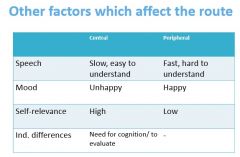
|
|
|
Theories of persuasion: Information processing models..
Hovland, Janis & Kelley (1953) |
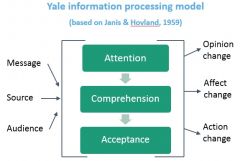
Considers impact of
Source (who is delivering it?) Message (what is the content like?) Audience (who is receiving the message?) |
|
|
General source effects + evidence
|
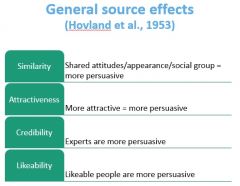
Hovland & Weis (1951)
Students read an article on nuclear subs More persuasive when ‘written by Robert Oppenheimer’ Chaiken (1979) Experimenter tried to persuade students to sign petition Students more willing when experimenter was attractive |
|
|
a ) Source effect - social identity
|
Linked to the idea of source similarity
If we see ‘persuader’ as being belonging to the same group as us, we are more persuaded Ingroup favouritism McGarty et al (1994) Highlighted group membership Participants were more persuaded by ingroup than outgroup member when group membership was salient |
|
|
b) Source effect -attribution of motives
internal (person attributions) and external motive (situation attributions) |
What is attribution?
When we figure out what is causing someone’s behaviour i.e. the content of their message We work out what we can 'attribute' their behaviour to Internal Attributes causes of message content to internal factors of the person e.g. personality, effort etc. Also called ‘person attributions’ External Attributes causes of message content to factors external to the person e.g. other people’s behaviour, aspects of the situation Also called ‘situation attributions’ How is attribution related to persuasion? Which attribution we make (person versus situation) affects persuasion Generally, situational attributions lead to higher persuasion Person attribution = ‘that person is biased; of course they are going to say that’ Situation attribution = ‘what they are saying is unbiased/caused by reality so must be true’ |
|
|
c) source effect - attribution of source EVIDENCE
Evidence - eagly and chaiken 1989 |
Participants read article about pros/cons of building car park on nature reserve by EITHER
Environmentalist Developer Expectations about what their internal motivation might be More persuasive when article violated expectations |
|
|
Message effects + evidence
|
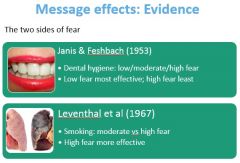
Two sided messages
E.g. advertising which compares product to inferior brands is more effective Provocation of emotion Fear inducing messages can be effective Too much fear is not effective Perceived intent Less obvious persuasion attempts are more effective |
|
|
Audience effects + evidence
|
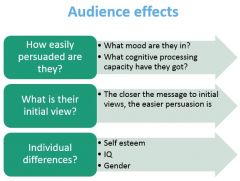
Generally females “easier to persuade” (e.g. Crutchfield, 1955)
Carli (1990) Manipulated Gender of source Assertiveness of source Gender of audience When female was tentative: Males easier to persuade than females |
|
|
Summary
|
Persuasion is an external way of bringing about attitude change
Two routes to persuasion Central/systematic Peripheral/heuristic Info processing approach emphasises impact of Message Source Audience |

